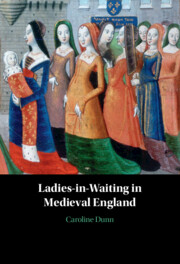Book contents
- Ladies-in-Waiting in Medieval England
- Ladies-in-Waiting in Medieval England
- Copyright page
- Dedication
- Contents
- Figures
- Tables
- Acknowledgments
- Abbreviations
- Introduction
- Part I The People of the Household
- Part II Rhythms of Life
- Part III Power and Its Rewards
- Chapter 5 Authority, Influence, and Power Politics
- Chapter 6 Rewards for Good Service
- Conclusion: Power, Authority, Influence, and Service
- Bibliography
- Index
Chapter 5 - Authority, Influence, and Power Politics
from Part III - Power and Its Rewards
Published online by Cambridge University Press: 02 January 2025
- Ladies-in-Waiting in Medieval England
- Ladies-in-Waiting in Medieval England
- Copyright page
- Dedication
- Contents
- Figures
- Tables
- Acknowledgments
- Abbreviations
- Introduction
- Part I The People of the Household
- Part II Rhythms of Life
- Part III Power and Its Rewards
- Chapter 5 Authority, Influence, and Power Politics
- Chapter 6 Rewards for Good Service
- Conclusion: Power, Authority, Influence, and Service
- Bibliography
- Index
Summary
Chapter 5 argues that the increasing number of female servants and resulting visibility of women at court had political ramifications. By exploring the more active roles played by ladies and damsels in political events of the realm, I demonstrate how female courtiers found ways to access privilege for themselves, their families, and other associates through intercession. For example, they dramatically assisted Isabella’s coup against her husband Edward II and courageously stood by Catherine of Aragon during her divorce crisis. On the other hand, when national sentiment turned xenophobic, a queen’s foreign attendants faced scorn, retribution, and even banishment during periods of conflict. Some female attendants faced misogynistic attitudes that attacked their perceived propensity toward immodest sexuality, greed, and darker forces like witchcraft and poisoning. This role of women at court – apart from queens and particularly notorious examples like Edward III’s mistress Alice Perrers – has been neglected in many discussions of medieval court politics and patronage. I contend that the hostility experienced by some female courters highlights how medieval contemporaries themselves recognized women’s potential access to insider information about monarchs and the favors that could be bestowed to their kin, friends, and associates.
Keywords
- Type
- Chapter
- Information
- Ladies-in-Waiting in Medieval England , pp. 205 - 239Publisher: Cambridge University PressPrint publication year: 2025

